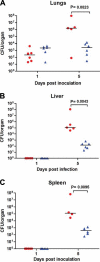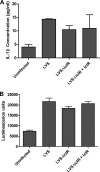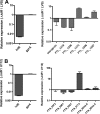Effects of the putative transcriptional regulator IclR on Francisella tularensis pathogenesis
- PMID: 20921148
- PMCID: PMC2981306
- DOI: 10.1128/IAI.00544-10
Effects of the putative transcriptional regulator IclR on Francisella tularensis pathogenesis
Abstract
Francisella tularensis is a highly virulent Gram-negative bacterium and is the etiological agent of the disease tularemia. IclR, a presumed transcriptional regulator, is required for full virulence of the animal pathogen, F. tularensis subspecies novicida U112 (53). In this study, we investigated the contribution of IclR to the intracellular growth, virulence, and gene regulation of human pathogenic F. tularensis subspecies. Deletion of iclR from the live vaccine strain (LVS) and SchuS4 strain of F. tularensis subsp. holarctica and F. tularensis subsp. tularensis, respectively, did not affect their abilities to replicate within macrophages or epithelial cells. In contrast to F. tularensis subsp. novicida iclR mutants, LVS and SchuS4 ΔiclR strains were as virulent as their wild-type parental strains in intranasal inoculation mouse models of tularemia. Furthermore, wild-type LVS and LVSΔiclR were equally cytotoxic and induced equivalent levels of interleukin-1β expression by infected bone marrow-derived macrophages. Microarray analysis revealed that the relative expression of a limited number of genes differed significantly between LVS wild-type and ΔiclR strains. Interestingly, many of the identified genes were disrupted in LVS and SchuS4 but not in their corresponding F. tularensis subsp. novicida U112 homologs. Thus, despite the impact of iclR deletion on gene expression, and in contrast to the effects of iclR deletion on F. tularensis subsp. novicida virulence, IclR does not contribute significantly to the virulence or pathogenesis of F. tularensis LVS or SchuS4.
Figures








Similar articles
-
Comparative review of Francisella tularensis and Francisella novicida.Front Cell Infect Microbiol. 2014 Mar 13;4:35. doi: 10.3389/fcimb.2014.00035. eCollection 2014. Front Cell Infect Microbiol. 2014. PMID: 24660164 Free PMC article. Review.
-
Live Attenuated Tularemia Vaccines for Protection Against Respiratory Challenge With Virulent F. tularensis subsp. tularensis.Front Cell Infect Microbiol. 2018 May 15;8:154. doi: 10.3389/fcimb.2018.00154. eCollection 2018. Front Cell Infect Microbiol. 2018. PMID: 29868510 Free PMC article. Review.
-
Differential Substrate Usage and Metabolic Fluxes in Francisella tularensis Subspecies holarctica and Francisella novicida.Front Cell Infect Microbiol. 2017 Jun 21;7:275. doi: 10.3389/fcimb.2017.00275. eCollection 2017. Front Cell Infect Microbiol. 2017. PMID: 28680859 Free PMC article.
-
Long-Term Survival of Virulent Tularemia Pathogens outside a Host in Conditions That Mimic Natural Aquatic Environments.Appl Environ Microbiol. 2021 Feb 26;87(6):e02713-20. doi: 10.1128/AEM.02713-20. Print 2021 Feb 26. Appl Environ Microbiol. 2021. PMID: 33397692 Free PMC article.
-
Comparative Transcriptional Analyses of Francisella tularensis and Francisella novicida.PLoS One. 2016 Aug 18;11(8):e0158631. doi: 10.1371/journal.pone.0158631. eCollection 2016. PLoS One. 2016. PMID: 27537327 Free PMC article.
Cited by
-
Trogocytosis-associated cell to cell spread of intracellular bacterial pathogens.Elife. 2016 Jan 23;5:e10625. doi: 10.7554/eLife.10625. Elife. 2016. PMID: 26802627 Free PMC article.
-
Comparative review of Francisella tularensis and Francisella novicida.Front Cell Infect Microbiol. 2014 Mar 13;4:35. doi: 10.3389/fcimb.2014.00035. eCollection 2014. Front Cell Infect Microbiol. 2014. PMID: 24660164 Free PMC article. Review.
-
Use of a capture-based pathogen transcript enrichment strategy for RNA-Seq analysis of the Francisella tularensis LVS transcriptome during infection of murine macrophages.PLoS One. 2013 Oct 14;8(10):e77834. doi: 10.1371/journal.pone.0077834. eCollection 2013. PLoS One. 2013. PMID: 24155975 Free PMC article.
-
Control of Francisella tularensis Virulence at Gene Level: Network of Transcription Factors.Microorganisms. 2020 Oct 21;8(10):1622. doi: 10.3390/microorganisms8101622. Microorganisms. 2020. PMID: 33096715 Free PMC article. Review.
-
Regulation of francisella tularensis virulence.Front Microbiol. 2011 Jan 6;1:144. doi: 10.3389/fmicb.2010.00144. eCollection 2010. Front Microbiol. 2011. PMID: 21687801 Free PMC article.
References
-
- Bosio, C. M., and S. W. Dow. 2005. Francisella tularensis induces aberrant activation of pulmonary dendritic cells. J. Immunol. 175:6792-6801. - PubMed
-
- Centers for Disease Control and Prevention. 2005. Tularemia transmitted by insect bites—Wyoming, 2001-2003. MMWR Morb. Mortal. Wkly. Rep. 54:170-173. - PubMed
-
- Centers for Disease Control and Prevention. 2009. Tularemia—Missouri, 2000-2007. MMWR Morb. Mortal. Wkly. Rep. 58:744-748. - PubMed
Publication types
MeSH terms
Substances
Associated data
- Actions
- Actions
- Actions
- Actions
- Actions
- Actions
- Actions
Grants and funding
LinkOut - more resources
Full Text Sources
Molecular Biology Databases

